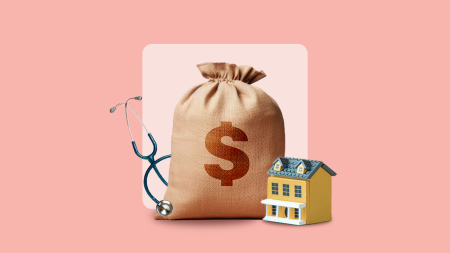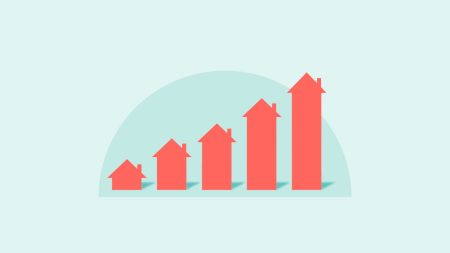Key takeaways
- Real estate is both a valuable personal asset and a leading indicator of the economy’s health.
- Types of real estate include residential, commercial, industrial and land properties.
- Real estate can be purchased either as a residence or as an investment, through loans or various forms of investing.
For millions of people, real estate — in the form of their homes and land — is the largest investment they will ever make, and the single most valuable asset they’ll ever own. The real estate market can also profoundly impact the nation’s economy as a whole. This fact was aptly demonstrated during the housing market crash of 2007, which in turn helped trigger the Great Recession (2008-09). For more about real estate explained and defined, read on.
Real estate definition
Real estate is a form of real property, meaning that it is something you own that is attached to a piece of land. It can be used for residential, commercial or industrial purposes, and typically includes any natural resources on the land, such as minerals or water.
Real estate is a piece of land, including any artificial or natural property permanently attached to it, above or beneath, such as a house, a building, a tree or minerals, according to Cornell University Law School’s Legal Information Institute.
Real estate is generally one of the most valuable assets a person can acquire as it typically appreciates over time. Subsequently, the value of real estate is a leading indicator of an economy’s health. Millions of jobs in home improvement, development, lending, insurance and business are directly impacted by the real estate market. The value of real estate is also reflected in homeownership, rental and property development rates.
Types of real estate explained
Real estate takes several forms, and depending on the type, various levels of regulation or restriction may apply to its purchase and use.
Residential
Residential real estate is used for the purpose of occupation. It comprises everything from single-family homes to multi-family rental units and can even include portable dwellings like houseboats.
While owning and occupying an individual home won’t generate an income, your property can develop significant equity over time. As your home’s value increases and you pay down your mortgage, your equity in your home rises, giving you a valuable asset over time that you can borrow against and leverage to further other financial objectives.
Multi-family real estate also appreciates in value over time, and can provide your own residence as well as generating significant rental income.
Commercial or industrial
Commercial real estate is used to conduct business or professional activities and generate income through commercial means. This typically means the owner allows other businesses to lease property on the land, which provides revenue. The owner may also own a business on the property themselves.
Industrial real estate is similar to commercial in that it’s also intended to turn a profit. Farms, mines and land with factories built on it are all considered forms of industrial real estate.
Land
Undeveloped land can be held vacant for future development or used to generate income through grazing, timber, agriculture or other uses. Even separate from other functional uses, land also tends to increase in value over time, making it a consistently strategic investment.
Purchasing real estate
Purchasing real property, such as a traditional single-family home, is generally facilitated by a licensed real estate agent, broker and/or attorney specializing in real estate transactions.
If you don’t have the means to purchase real estate outright, in cash, the purchase can be financed. Most people purchase residential real estate with a real-estate-specific loan called a mortgage. In the U.S., mortgages come in many forms and are traditionally backed or insured by either the federal government or a private lender.
The mortgage options available to you will depend on the type of real estate you’re buying, your credit score and your financial resources. Most mortgages require a down payment that commonly ranges from 3.5 to 20 percent of the home’s purchase price. Saving enough for a down payment can be a significant barrier to homeownership — for example, a 20 percent down payment on a $300,000 home is $60,000, a daunting sum for many.
Investing in real estate
Purchasing real estate for investment can be done out-of-pocket, through traditional lending sources like banks or via sources like hard money lenders and private lenders. There are also more out-of-the-ordinary solutions — such as real estate crowdfunding platforms — that can allow you to acquire real estate in other ways.
Real estate can be purchased as a buy-and-hold asset, which aims to generate income through short-term, long-term or vacation rentals. House flipping is another common form of real estate investing, in which the buyer adds value to a purchased property and then sells it for a profit. Buy-and-holds and flips are most common with single-family and multi-family assets but can also apply to commercial-use properties.
If investing in real estate on your own presents too much risk, it’s also possible to purchase a fractional share of a property or asset through a syndication, partnership or investment fund. This diversifies risk to the limited partners and provides equity and distributions to all partners. This is often called passive real estate investing, as you don’t directly manage the property; your money is put to work for you by experienced investors.
Other ways to purchase real estate include real estate investment trusts (REITs), real estate limited partnerships (RELPs) and master limited partnerships (MLPs). REITs, which trade like stocks on financial exchanges, are the easiest for beginners to find and invest in. Most major investment brokerage firms offer them. All these options diffuse the risk of investing in real estate as an individual by reducing the upfront cost, offering an extensive portfolio of properties and sharing the risk among a large group of people.
Historic moments in U.S. real estate
- 1908: The National Association of Realtors is founded in Chicago.
- 1920s: The multiple listing service (MLS), a centralized system for advertising and finding homes for sale, comes into use and is widely adopted around the U.S.
- 1934: The Federal Housing Administration is established to kickstart the home-construction industry and create lending guidelines.
- 1938: The Federal National Mortgage Association, colloquially known as Fannie Mae, is created as part of Franklin D. Roosevelt’s New Deal. During the Great Depression, banks foreclosed on thousands of properties and were left with very little cash with which to extend new loans. Fannie Mae’s job was to purchase mortgages from lenders and repackage them as securities that could be invested in. By buying the mortgages, Fannie Mae gave banks liquidity to extend credit to new borrowers.
- 1940s-50s: The suburbs expand with the baby boom and an influx of cash from the GI bill, signed into law in 1944, which gives veterans returning from World War II access to cheaper government loans for housing.
- 1968: The Fair Housing Act passes, prohibiting discrimination based on race, national origin, religion, gender, sexual orientation, disability and more in buying, renting, selling or home financing.
- 1970: The Federal Home Loan Mortgage corporation, known as Freddie Mac, is created to expand the secondary mortgage market. It increases the number of mortgages purchased from lenders, giving them even more liquidity to extend loans to borrowers.
- 2006-07: The subprime mortgage crisis hits, causing a wave of foreclosures, the bankruptcy of several lenders and financial services firms, and a subsequent recession.
- 2010: The Dodd-Frank Act is passed, creating the Consumer Financial Protection Bureau and reforming mortgage lending.
Read the full article here










